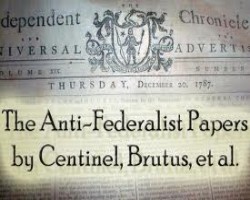Constitutional Commentary
Unlike in Bible where it is sometimes hard to get the original intent of the author's writing or exactly what certain phrases or words meant or what, exactly, they were referring to; the Constitutional framers wrote prolifically about what was meant in the Constitution that they wrote. Two of the most important collection of documents to help us understand exactly what was meant in the Constitution are the Federalist Papers and the Antifederalist Papers.
(Click on the TITLES, which are the links to the documents)
The Federalist Papers
Written predominately by Alexander Hamilton (who wrote over half), John Jay (1st U.S. Chief Justice), and James Madison (4th U.S. President who was also known as the "Father of the Constitution") the Federalist Papers are a collection of 85 articles that were written and published in Newspapers and periodicals throughout the colonies in order to win the people over to ratifying the new constitution.
The Anti-Federlist Papers
While most people have heard about the federalist papers, lesser known is a collection of articles and speeches by various people who were opposed to the new constitution and their reasoning behind it. One of the more famous of the antifederalists is Patrick Henry. It was the antifederalists who were predominately responsible for the ratification of the "the Bill of Rights" and thank God for theri inclusion. The Bill of Rights has been the last hurdle for the U.S. Government to cross to eliminate the last vestige of personal liberty in the United States. Also important to note in the antifederalist papers is that many of the predictions of what would happen if the Constitution was ratified have either already come true is were are seeing come to pass before our very eyes right now. One of those predictions that has already come true is found in Antifederalist Number 7 -"Adoption of The Constitution Will Lead to Civil War," which happened about 75 years after ratification. One of the predictions that we are seeing unfold before our very eyes is found in antifederalist 17 - "Federalist Power Will Ultimately Subvert State Authority" and Antifederalist 78 -83 - "The Power of the Judiciary."
It may be even more important to understand the antifederalist arguments now that we are seeing so many of their predictions come to pass, but it's certainly important to understand the original intent of the Constitution as well.
View of the Constitutional of the United States of America
St. George Tucker, 1803: St. George Tucker’s View of the Constitution of the United States was the first extended, systematic commentary on the Constitution after it had been ratified by the people of the several states and amended by the Bill of Rights. Published by a distinguished patriot and jurist, it was for much of the first half of the nineteenth century an important handbook for American law students, lawyers, judges, and statesmen. Though nearly forgotten since, Tucker’s work remains an important piece of constitutional history and a key document of Jeffersonian republicanism.
A View of the Constitutional of the United States of America ![]()
By William Rawle, 1825: Rawle wrote in his preface, "If the following work shall prove useful, as an elementary treatise to the American Student, the author will be gratified. If Foreigners are enabled, by the perusal of it, to obtain a general idea of the merits of the Constitution, his satisfaction will be increased. The the American Public in general, its value may chiefly consist in the exhibition of those judicial decisions, which have settled the construction of some points that have been the subject of controversy."
Government 
By James Mill, 1825: Reprinted from the Supplement to the Encyclopedia Britannica. While not a commentary on the Constitution in the truest sense, this 32 page treatise is a VERY important commentary to this new Constitutional Government that was just formed and addresses some VERY important principles beneath it.
A Brief View of the Constitution of the United States 
This short essay was published in 1831 by Peter S. Du Ponceau, just two years before the Joseph Story commentaries. It was address to the Law Academy of Philidelphia af which he was the Provost.
Joseph Story Commentary
Published in 1833, these commentaries are one of the most comprehensive and important commentaries ever written. This was just 46 after the signing of the Constitution. Joseph Story was a Chief Justice who was intimately involved in shaping the "meaning" of the Constitution in the early days for American. He HEAVILY references the Federalist Papers as well as many other documents that were contemporary in his day.
A Treatise on the Constitutional Limitations 
FULL TITLE: A Treatise on the Constitutional Limitations Which Rest Upon the Legislative Power of the State of the American Union.
By Thomas M. Cooley, One of the Justices of the Supreme Court of Michigan, and Jay Professor of Law in the University of Michigan.
1871




